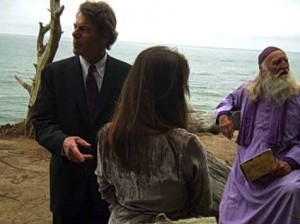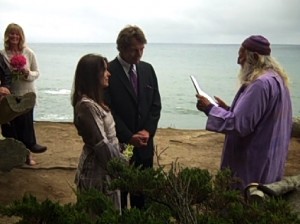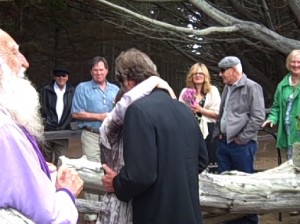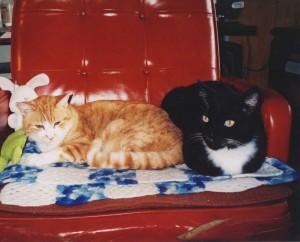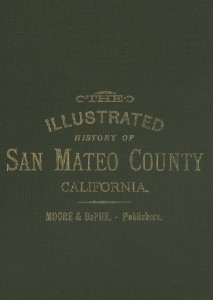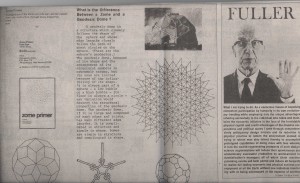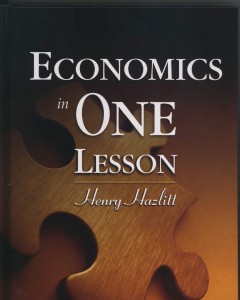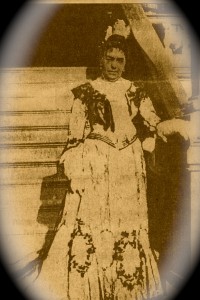Seen on University Ave in Palo Alto.
Mysterious Wedding in the Magical Forest, Moss Beach
Virtual Parks: Montara Mountain….Pillar Point
From John Vonderlin
email John ([email protected])
To view a panorama of Montara Mountain, click here
Sam and Mickey are not related
All the good books are out-of-print
What’s the difference between a “zome” and a “dome?” We’ve got our answer
See Russell Towle’s explanation below.
Russell Towle is a mathematician, amateur geologist, and local history writer who currently working on an article about zonotopal tilings.
“Zome is a word coined by Steve Baer as I recall, based upon “dome,” the difference being that the geodesic dome of [Buckminster] Fuller was formed upon a network of triangles, wheres zomes are bounded by zonogons, a zonogon being a convex, centrally-symmetrical polygon. A rhomb is a zonogon, so are all regular polygons with an even number of sides, but a zonogon need not be regular.”
Good Book…..Easy to Understand…Answers Questions About Today’s “Problems”
Summer Reading: The Story of Jane Lathrop Stanford (10) Finale
I wrote the story in 1999
This is the story of Jane Lathrop Stanford and the mysterious circumstances surrounding her death in the early 1900s.
Part 10
While the autopsy was completed, the chemist’s report was inexplicably delayed. Suspicion arose when Honolulu’s High Sheriff William Henry cabled San Francisco police with a message that “the bottle of bicarbonate of soda contained 43 grams, in which there were 662 grains of strychnine.”
Then came a bombshell. High Sheriff Henry denied he was the author of the cable and did not know what was in the still unreleased chemist’s report.
After further delay, there was an inquest featuring a parade of witnesses. Bertha Berner, who was a suspect, remained in her room while testifying. Wearing a white, long-sleeved dress with a high collar, she had prepared herself well. As she described Mrs. Stanford’s last moments she clasped a handkerchief with her long, slender fingers adorned with a “dozen rich rings.”
While the autopsy surgeons pointed to strychnine as the cause of death, the chemists said they found only one-half a grain of strychnine in the 43 grains of bicarbonate of soda.
The Honolulu Coroner’s Jury issued its own verdict: “Mrs. Stanford came to death by poisoning, strychine having been given to her with murderous intent by a person or persons unknown to the jury.”
The verdict set the San Francisco police into motion as detectives scoured the Nob Hill mansion and the Palo Alto Farm for traces of strychnine. None was found. Strchnine had to be registered at the point of purchase and local pharmacists were interviewed. If the police could not trace the deadly poison to a purchaser, officials said they would have insufficient evidence for a conviction.
Detectives focused on Mrs. Stanford’s servants, subjecting them to the “third degree” in a darkened room on the first floor of the Nob Hill mansion. In that room police heard accounts of petty rivalry, jealousy and intrigue.
Albert Beverly and Elizabeth Richmond, the dismissed butler and maid residing in San Mateo, underwent two hours of “sweating” at San Francisco police headquarters. Nothing new was learned.
After being shadowed and harassed by police, Elizabeth Richmond broke down and admitted, “We all knew what was going on about my old mistress,” referring to the household graft. She accused Bertha Berner of sharing in the profits and of exerting undue influence over Mrs. Stanford.
But Bertha retained the full confidence of the entire Stanford estate. Bertha and Ah Wing were loyal, and not greedy, since they were always adequately recompensed, it was said.
Following Mrs. Stanford’s death, the Stanford team seemed anxious to conclude that Mrs. Stanford was not murdered.
How did Dr. David Starr Jordan, a medical doctor, and the president of Stanford University, deal with the presence of strychnine in the bicarbonate of soda? He contended the presence could have been a pharmacist’s error, or mixed with the soda as a tonic. As Dr. Jordan familiarized himself with Mrs. Stanford’s symptoms, he concluded she was not poisoned because the strychnine found did not exceed “a medicinal dose.” She died a natural death, he said.
The natural death theory gained momentum as San Francisco police were unable to uncover more than details “relating to certain jealousies and trouble between Mrs. Stanford’s servants.”
Agreeing that the amount of strychnine found was insufficient to kill Mrs. Stanford, the police closed the case. Mrs. Stanford’s passing was classified as a natural death caused by heart disease, brought on by an acute attack of indigestion.
At the reading of Mrs. Stanford’s will, Bertha Berner received $15,000, and Ah Wing received $1,000. Bertha retired to Menlo Park; a personal account of her life with Mrs. Stanford was published by the University Press in 1935.
But Mrs. Jane Lathrop Stanford’s death remained controversial as some of her friends continued to believe she had been poisoned. They also believed the culprit worked secretly and alone, and his or her identity would never be know.
———-
Finis
Summer Reading: The Story of Jane Lathrop Stanford (9)
I wrote this in 1999.
This is the story of Jane Lathrop Stanford and the strange circumstances surrounding her death in the early 1900s.
Jane Stanford canceled all engagements, even the much anticipated society debut of her favorite niece. With Bertha Berner she feld to her Palo Alto country estate. She confided to friends that she intended never to return to the Nob Hill mansion. Fearing for her life she planned a voyage accompanied by Bertha and May Hunt, bound for Honolulu and safety.
Before embarking in early February 1905, a strange conversation took place.
With Mrs. Stanford’s consent, a representative of the Stanford estate informed Bertha that Mrs. Stanford had signed a new will. Bertha was told she was not a beneficiary of the revised testament, and neither were any of the other servants.
Aboard ship, Bertha observered Jane Stanford’s melanchly mood, but she noted that the widow recovered her high spirits at Honolulu’s Moana Hotel, mingling with friends and taking invigorating drives around the scenic island of Oahu.
She chatted with May Hunt about continuing to Japan, then became depressed once again.
“How dreadful it would have been if I had died that time (Jan 14),” she said. “People might have thought I committed suicide.” Indeed there were a few proponents of the attempted suicide theory, a notion abhorred by representatives of the Stanford estate.
At the Moana Hotel, Mrs. Stanford met with Mrs. Henry Highton, a friend from California. The “poisoning” attempt was foremost in her mind, said Mrs. Highton, adding that Mrs. Stanford was “terribly worked up over the whole affair and said she feared another effort would be made to kill her. She told me that enough poison to kill 20 people had been placed in a bottle of mineral water in San Francisco last month.”
On February 28, Mrs. Stanford enjoyed a hearty lunch but only ordered a bowl of soup for dinner before retiring to her hotel room. She asked Bertha to prepare her medicines including a half-teaspoonful of bicarbonate of soda and a glass of mineral water.
About 11 p.m. she awoke and realized she had forgotten to take the bicarbonate of soda which she then swallowed with the mineral water. She was gripped by nausea, suffered severe pain and waves of convulsions. She called for May Hunt and Bertha Berner, who were asleep in a room across the hallway, and they rushed to Mrs. Stanford’s side
“Get me a doctor quick. I have been poisoned. This is a terrible death to die,” cried Mrs. Stanford.
Dr. Humphris, a guest on the same floor of the Moana Hotel, was quickly summoned. In between convulsions, she told the doctor: “This is the second time they have tried it. They tried it last January, and I came here to avoid them” She did not identify who “they” might be.
Dr. Humphris could not save his famous patient’s life, and minutes later the co-founder and “mother” of Stanford University died.
The doctor was certain the medicine, not the water, contained strychnine. Breaking the rules of preserving evidence, he took the bicarbonate of soda to his hotel room, holding it there until the Honolulu authorities arrived.
As soon as the San Francisco police learned of Mrs. Stanford’s death, a possible murder by poisoning, they sought to share jurisdiction with Hawaiian officials. If this was a poisoning case, the poison was prepared in their city.
(coming Part 10)
Summer Reading: The Story of Jane Lathrop Stanford (8)
I wrote this in 1999.
This is the story of Jane Lathrop Stanford and the mysterious circumstances surrounding her death in the early 1900s.
Part 8
Bertha Berner was immediately summoned and handed Mrs. Stanford glasses of warm salt water easing her distress. When Elizabeth Richmond peered into the bottle she saw undissolved particles of a mysterious substance, and took the container to the downstairs kitchen.
Bertha, with Elizabeth Richmond at her side, inserted her index finger into the water, tasted it, and said it made her feel ill. Later the maid denied that the incident occurred.
When some of Mrs. Stanford’s relatives heard about the “poisoning,” they brushed it off, stating she was a “victim of hallucinations, prone to declare she had been poisoned whenever she became indisposed.”
But Mrs. Stanford was convinced someone in the mansion had tried to poison her, and she directed attorney Montford Wilson to retain the Harry N. Morse Detective Agency to quietly investigate, including conducting a chemical analysis of the mineral water.
The chemist’s report was kept secret, but it was finally learned that enough strychnine lurked in the water to kill at least four people. The Morse Detective Agency’s involvement in the case brought to light many theories: The Chinese housekeeper suspected Bertha Berner of the deed as she was the only person with the opportunity to poison the water. Another speculation was that the poison was meant for Bertha, or that the poisoning was an act of revenge on the part of the housekeeper or someone else.
The theory that a jealous servant wanted to cast blame on another had strong support, but private detective Harry N. Norse did not buy any of these theories, and he failed incriminate anyone.
Shortly after the “poisoning,” an eye-glass hook became loose on the dress worn by Mrs. Stanford. She wanted the maid, Elizabeth Richmond, to repair the garment immediately. Richmond took the dress to her room, returning it the following morning. When reprimanded by Mrs. Stanford the maid responded with a “flash of anger.”
A few days later, Elizabeth Richmond was relieved o fher duties and replaced by May Hunt, a former employee. With no place to go, Albert Beverly invited Richmond to stay with his family in San Mateo until she found a new position.
(Part 9 next)




